The issues of climate and future temperature increases have become part of our everyday life, and central in this debate is carbon dioxide. The fossil fuels we use contain carbon and hydrocarbon compounds, and carbon dioxide is released together with energy when we burn these.
However, it seems that the amounts of fossil fuels themselves are not perceived as a problem among those debating climate change. Instead, the problem is only ever that we are expected to use too much of them. The idea that the combined volumes of these fuels are insufficient to cause the changes in climate that are currently discussed is nowhere to be heard.
At Mexico’s enormous oilfield named Cantarell, production is declining very rapidly.
Advertisement
In 2005 the Mexican oil company Pemex presented two scenarios for how much oil Cantarell would ultimately produce: an optimistic estimate where they could extract 50 per cent of the oil originally in place in the oilfield; and a pessimistic estimate of only 30 per cent.
For the national oil company Pemex and for Mexico it is, of course, a severe blow that the reality now appears to be consistent with the more pessimistic scenario: but, having said that, our climate stands to benefit. We have now come to an important decision-making point. Shall we regard the oil that remains underground as a resource that can cause future carbon dioxide emissions or shall we accept that it is, in fact, inaccessible?
The UN’s climate panel IPCC, that recently published its fourth report on climate change, regards the oil left in ground as a resource.
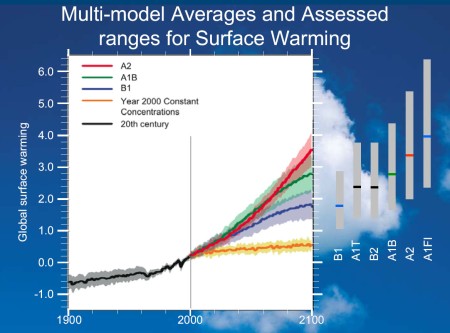
Figure 1: Average temperatures and temperature ranges predicted in different IPCC scenario families.
Advertisement
With its immense computer models - a kind of “SimCity-IPCC game” - the IPCC has simulated our future. The families in the game are called A1, A2, B1 and B2. Every family has a predetermined future in terms of population, GDP-growth, land use, available resources and technology development. (See Figure 1.)
The worst case scenario in terms of future temperature increase is for family A2. If their scenario is realised the temperature by 2100 will be a whole 3.6C higher than today.
The least troublesome family is B1: they can expect a temperature increase of 1.8C.
The precondition for any of these temperature increases is that we consume large volumes of oil, natural gas and coal. The fact that the IPCC calls upon our politicians to make decisions that will discourage use of fossil fuels creates an impression that enormous fossil fuel resources exist: but following the research that we do at the Uppsala Hydrocarbon depletion study Group, UHDSG, there is every reason to question this.
At Uppsala University, we study global energy resources and we have now completed a detailed analysis of future oil production. By breaking down production into seven well-defined parts we can now give a timeframe for the moment when we will reach the maximum production rate for oil, or “Peak Oil” - the historical production peak.
It will occur between 2008 and 2018. If the world’s giant oilfields, that produce 60 per cent of the world oil, behave like Cantarell we have a “worst case scenario” with a production peak in 2008. But if, instead, they follow the best prognosis for Cantarell, and we simultaneously reduce our consumption, then we get a “best case scenario” with maximal production in 2018. The “Giant High Case” is shown in Figure 2:
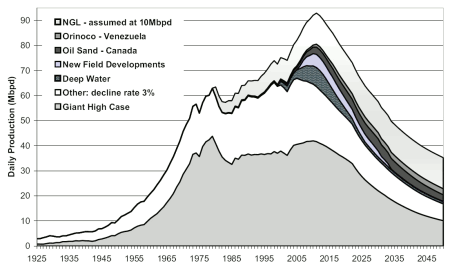
Figure 2: A scenario for world oil production built on optimistic assumptions for oil contributions from the seven types of oil source (NGL - natural gas liquids, heavy oil from the Orinoco region of Venezuela, Canadian oil sands, new conventional oil fields, production in deep water, the Giant High Case and an optimistic low decline of just 3 per cent for the rest of today’s conventional oil production) [Thesis of Fredrik Robelius].
We can now calculate how much energy/carbon dioxide we can expect to produce this century if the oil is used and compare it with the energy that the IPCC-families require. To our amazement we see that all the families, A1, A2, B1 and B2, require more oil than is realistic.
If we extend our analysis and study future natural gas production and what the IPCC families require we get an even clearer picture. Natural gas production is declining in North America, as is production in the gigantic Russian gas fields in northwest Siberia that today accounts for 90 per cent of Russian production. Planned projects to make diesel fuel from natural gas in Qatar are being cancelled. Planned reception terminals for liquefied natural gas in the USA and Europe are being down-sized because the global production of liquefied natural gas is now not expected to be what we were counting on a few years ago.
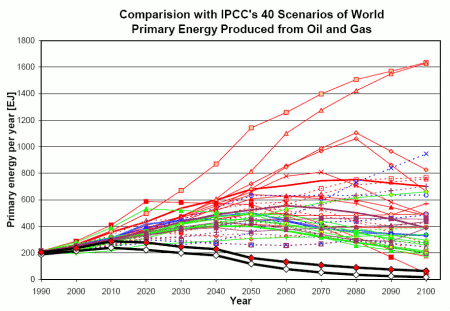
Figure 3: IPCC’s 40 scenarios for world primary energy production from oil and gas 1990 - 2100 compared to the production according to the oil depletion model. The group All Oil and Gas includes heavy oil, extra heavy oil, deepwater oil, polar oil, gas plant NGL, condensate, and non-regular gas e.g. coal bed methane [
Anders Sivertsson].

Natural gas is considered by many to be a “bridging fuel” to a future renewables-based society. Today the bridge seems to be shorter than previously believed, but in terms of carbon emissions once again we stand to benefit.
The third component to be considered for carbon dioxide emissions is coal. The commonly held belief is that virtually unlimited quantities of coal exist, but when we make detailed analyses of production profiles in those six nations that have 85 per cent of the world’s coal reserves, USA, China, Russia, Australia, India and South Africa, we discover clear signs that coal production in particular regions has reached maximum capacity. Furthermore, we see a decline in production of the best coal, i.e. that which has the highest energy content.
In the USA, the world’s second largest coal user, the volume of coal mined is increasing but its total energy content is decreasing. The USA has reached a coal maximum, “Peak Coal”, in terms of energy content.
China will soon reach its maximum coal production capacity and we will then be in a situation where Russia alone sits on the last great coal reserves. The moment in history when we reach “Peak Coal” will be determined by Russia’s future coal production.
So compared with what has been previously asserted, we are going to be much better off in terms of carbon dioxide emissions.
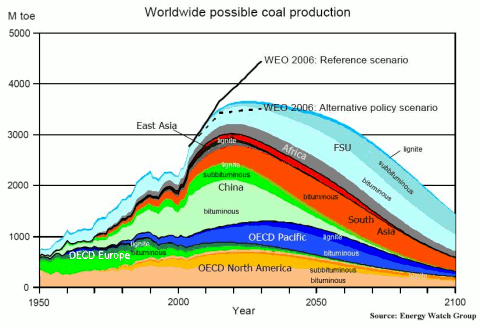
Figure 4: World possible coal production.
The total sum of all fossil fuel resources that industry considers accessible is reported every year in the BP Statistical Review. If we use this optimistic value then the total energy available from all reserves of oil, natural gas and coal equals 36 ZJ (Zeta Joules, 1x1021 joules), a gigantic quantity. This is more than our research group considers possible but is less than that needed for all the scenarios that families A1, A2, B1 and B2 require. The fossil fuel energy is insufficient.
Family A2, is our worst case in terms of temperature increase so let us study its energy hunger. In the years to 2100 the IPCC estimates that A2 requires between 70 and 90 ZJ, in other words double the amount that industry believes is accessible. Then there is another small detail that is almost never discussed, namely that all the families also require fossil fuel energy after 2100. (In Figure 3 all the scenarios require additional oil and gas during the 22nd century. IPCC has not discussed this.)
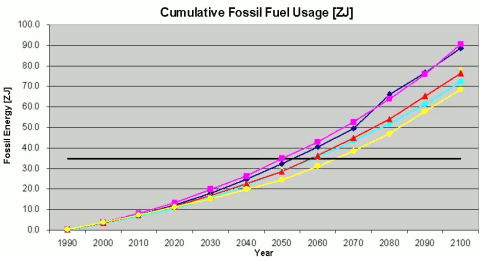

Figure 5: Cumulative fossil fuel usage for family A2, 70 to 90 Zeta Joules, compared with the total fossil reserves according to BP Statistical Revue, 36 Zeta Joules.
We have no need to discuss or dispute the temperature increase up to the present day, but we must discuss and dispute the temperature increases that the IPCC-families indicate and the fossil fuel resources that the IPCC uses in its prognoses.
We need new estimates of future temperature increases based on realistic expectations of oil, natural gas and coal use. Only then can we make sensible decisions for our future.
The world’s greatest future problem is that too many people must share too little energy. In the current political debate we presumably need to replace the word “environment” with “energy”, but the policy required to tackle the energy problem will greatly benefit the environment.